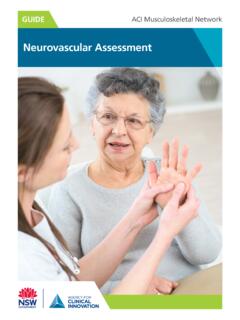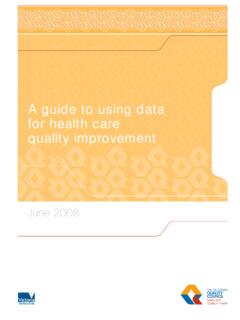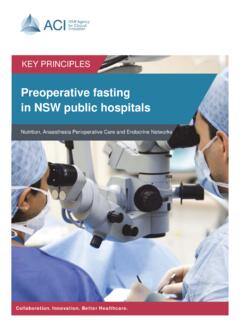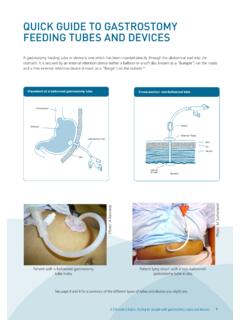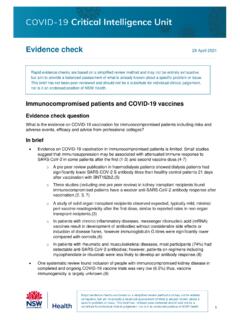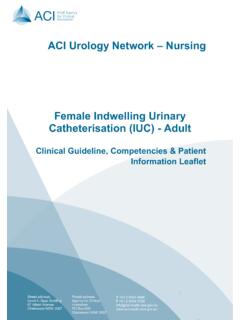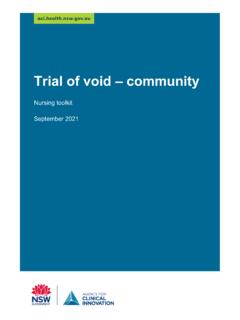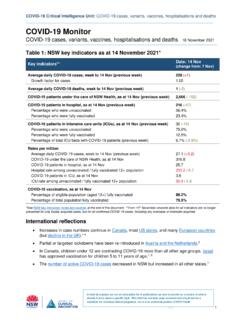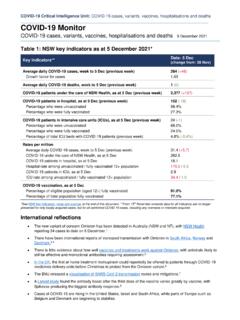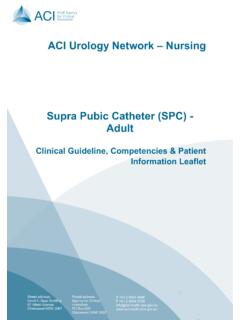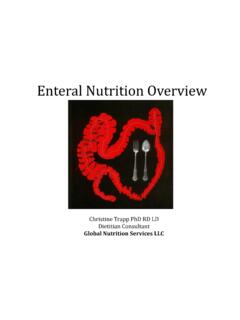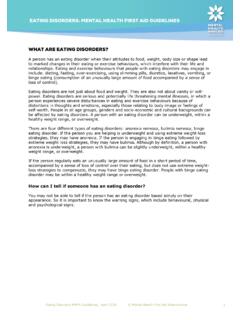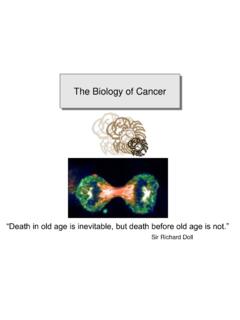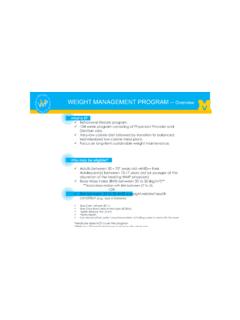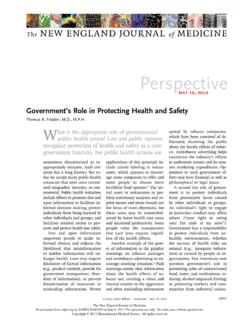Transcription of PARENTERAL NUTRITION POCKETBOOK
1 PARENTERAL NUTRITION . POCKETBOOK : FOR ADULTS. AGENCY FOR CLINICAL INNOVATION. Tower A, Level 15, Zenith Centre 821-843 Pacific Highway Chatswood NSW 2067. PO Box 699. Chatswood NSW 2057. T +61 2 8644 2200 | F +61 2 8644 2151. E | Produced by: ACI Gastroenterology Network ACI NUTRITION Network SHPN: ACI 100520. ISBN: 978 1 74187 606 2. Further copies of this publication can be obtained from the Agency for Clinical Innovation website at: Disclaimer: Content within this publication was accurate at the time of publication. This work is copyright. It may be reproduced in whole or part for study or training purposes subject to the inclusion of an acknowledgment of the source. It may not be reproduced for commercial usage or sale. Reproduction for purposes other than those indicated above, requires written permission from the Agency for Clinical Innovation. Agency for Clinical Innovation 2010. Published: May 2011. FOREWORD. The Agency for Clinical Innovation (ACI), formerly the Greater Metropolitan Clinical Taskforce (GMCT), was established by the NSW.
2 Government as a board-governed statutory health corporation in January 2010, in direct response to the Special Commission of Inquiry into Acute Care Services in NSW Public hospitals. The ACI drives innovation across the healthcare system by using the expertise of its clinical networks to design, cost and recommend innovative, evidence-based improvements to public health care services in NSW, for implementation on a state-wide basis. PARENTERAL NUTRITION (PN) is a life sustaining therapy for patients who cannot eat or tolerate enteral NUTRITION . However, there are significant infection risks and complications associated with intravenous feeding. The ACI was approached by clinicians providing PN to develop a resource to support colleagues working in facilities where PN is less frequently used and to identify best care practices for PN for NSW public health facilities. The project, funded by the GMCT (now ACI), commenced in early 2008. and has been a collaborative effort by the ACI's Gastroenterology and NUTRITION Networks.
3 The PN working group involved clinicians from across NSW, including medical practitioners from a number of specialties, nurses, dietitians, pharmacists and consumers. On behalf of the ACI, I would like to thank the Chair of the working group, Professor Ross Smith and all the members for their dedication and expertise in developing this PN POCKETBOOK . Hunter Watt Chief Executive, Agency for Clinical Innovation ACI - PARENTERAL NUTRITION POCKETBOOK : for Adults 1. 2 ACI - PARENTERAL NUTRITION POCKETBOOK : for Adults TABLE OF CONTENTS. 1. 5. 1. Principles of NUTRITION 7. Malnutrition & Principles of NUTRITION Malnutrition Indications for NUTRITION Indications for PARENTERAL When is it not appropriate to use PARENTERAL NUTRITION ?..11. 2. NUTRITION Assessment of the Adult PN 3. Venous Access for PN in the Adult Central Venous Peripheral Venous Care and Management of Vascular 4. PN Requirements for the Adult 27. Patients at Risk of Refeeding Patients Not at Risk of Types of PN Solutions Available for Adult Ward PN Macronutrient Requirements for the Adult Ward 30.
4 PN Micronutrient Requirements for the Adult Ward 5. PN for the Critically Ill Adult 49. 6. PN Solution Stability/Compatibility 7. Monitoring Adult Patients on 8. 59. 9. Transitional 10. Ceasing 63. 65. 66. ACI - PARENTERAL NUTRITION POCKETBOOK : for Adults 3. 4 ACI - PARENTERAL NUTRITION POCKETBOOK : for Adults PREFACE. PARENTERAL NUTRITION (PN) refers to the intravenous infusion of specialised NUTRITION solution. This method of feeding may be required when the gastrointestinal tract is not functional or leaking, cannot be accessed, or the patient cannot be adequately nourished by oral or enteral means. In NSW, there are major variations in the way PN is administered in public hospitals. Furthermore, hospitals in outer metropolitan and rural regions of NSW may have limited support in the area of PN and its administration. Commercially premixed solutions can provide adequate NUTRITION over short periods but for more complex patients, it is important to have a flexible system to personalise PARENTERAL NUTRITION available in larger hospitals.
5 This POCKETBOOK aims to provide principles of PN therapy for adult patients to ensure consistency throughout NSW wherever patients are managed. Children have very specific nutritional requirements which are individualised to their age, clinical condition and disease. Therefore, PN in paediatrics is not addressed as part of this book. PN is complex and expensive and should therefore be used with good clinical guidance. The POCKETBOOK provides guidance for clinicians on the indications for PN, NUTRITION assessment of the PN patient, determining PN requirements, initiating PN, monitoring complications and ceasing PN. PN is best managed by a multidisciplinary team that should be guided by an interested clinician (gastroenterologist, GI surgeon and intensivist), but that importantly involves NUTRITION nurses, dietitians and pharmacists, together with biochemistry and microbiology laboratory support if necessary. In smaller hospitals these roles can be shared.
6 I would like to thank all those who volunteered to undertake the tasks of reviewing a large volume of the literature to complete what has been a successful project. Professor Ross Smith Chairman of ACI TPN working group Professor of Surgery, Northern Clinical School University of Sydney ACI - PARENTERAL NUTRITION POCKETBOOK : for Adults 5. 6 ACI - PARENTERAL NUTRITION POCKETBOOK : for Adults 1. PRINCIPLES OF NUTRITION SUPPORT. Malnutrition & Principles of NUTRITION Support Malnutrition is common in hospitalised patients. Prevalence rates of malnutrition reported in Australian hospitals are around 30%1,2. Nutritional status can decline significantly over the course of a patient's admission, due to a combination of reduced NUTRITION intake and increased requirements secondary to the impact of the disease process (altered metabolic requirements, increased nutrient losses and reduced consumption, digestion and absorption). Timely and appropriate NUTRITION support aims to prevent malnutrition in those at risk and treat those who are malnourished.
7 Malnutrition is associated with increased morbidity and mortality;. increased length of hospital stay and hospital costs; and increased risk of infections, delayed wound healing, impaired respiratory function, electrolyte disturbances and post-operative complications. Malnutrition Screening Malnutrition screening enables the early identification of patients who may benefit from NUTRITION support. Leading NUTRITION groups worldwide recommend routine NUTRITION screening of hospitalised patients3,4,5. There are several validated NUTRITION screening tools available, the most well-known being the MUST and MST6,7,10. NUTRITION screening should be undertaken on admission and repeated on a regular basis for long-stay patients. Patients should have their NUTRITION history and weight recorded and those at risk should be flagged and referred for further NUTRITION assessment and intervention. An automated screening tool has been developed and validated in upper gastrointestinal (GI) surgical patients8.
8 ACI - PARENTERAL NUTRITION POCKETBOOK : for Adults 7. If screening indicates the patient is at increased risk of malnutrition, a thorough assessment should be done (Refer to Section 2). Indications for NUTRITION Support NUTRITION support (oral, enteral or PARENTERAL ) should be considered for all patients who are malnourished or are at risk of malnutrition. To diagnose malnutrition, use the ICD-10-AM Sixth Edition criteria11. E43 Unspecified severe protein energy malnutrition I n adults, BMI < kg/m2 or unintentional loss of weight ( 10%) with evidence of suboptimal intake resulting in severe loss of subcutaneous fat and/or severe muscle wasting. E44 Protein-energy malnutrition of moderate and mild degree I n adults, BMI < kg/m2 or unintentional loss of weight (5 9%) with evidence of suboptimal intake resulting in moderate loss of subcutaneous fat and /or moderate muscle wasting. I n adults, BMI < kg/m2 or unintentional loss of weight (5 9%) with evidence of suboptimal intake resulting in mild loss of subcutaneous fat and/.
9 Or mild muscle wasting To identify those at risk of malnutrition9: H. ave eaten little or nothing for more than five days and/or are likely to eat little or nothing for the next five days or longer H. ave increased nutritional needs from causes such as catabolism, high nutrient losses or poor absorptive capacity The above indications should be considered in light of results of a full NUTRITION assessment. 8 ACI - PARENTERAL NUTRITION POCKETBOOK : for Adults Indications for PARENTERAL NUTRITION PARENTERAL NUTRITION (PN) can sustain life when patients are unable to take sufficient nourishment via the gastrointestinal tract for prolonged periods. However, PN is associated with significant risks and complications. Alternative methods of nourishing patients should be considered in every case. A NUTRITION support algorithm is presented in Figure 1. Where possible, oral or enteral NUTRITION are preferred options. PN is necessary when the patient cannot be sustained with either increased intake of oral supplements or enteral NUTRITION alone.
10 The use of PN should be considered when normal oral intake or enteral NUTRITION cannot be started after a period of five days. Short-term PN is appropriate in malnourished and/or severely catabolic patients unable to be adequately nourished enterally. In this patient group, the risks of complications of NUTRITION depletion are greater and PN should be started earlier. As PN is an invasive therapy, it must be used in a manner which limits the risk of sepsis, catheter insertion complications and metabolic complications. PN is also a relatively expensive treatment which can only be justified for patients with clearly defined indications. The basic indication for using PN is a requirement for NUTRITION when the gastrointestinal tract is either: not functional or leaking ( obstruction, ileus, fistulae, dysmotility). cannot be accessed ( intractable vomiting with inability to establish jejunal access). the patient cannot be adequately nourished by oral or enteral means ( in malabsorption states such as short bowel syndrome, radiation enteritis or inability to establish full enteral feeding) 9.
